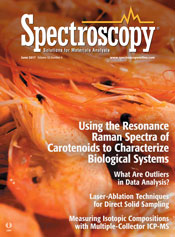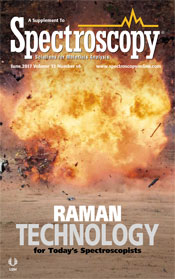In our June issue:
COLUMNS
Molecular Spectroscopy Workbench
Carotenoids—Their Resonance Raman Spectra and How They Can Be Helpful in Characterizing a Number of Biological Systems
Fran Adar
The resonance Raman spectra of carotenoids vary with subtle changes on the functional side groups, making these spectra useful for identifying and characterizing carotenoids.
Read more »
|

|
Chemometrics in Spectroscopy
Outliers, Part I: What Are Outliers?
Howard Mark and Jerome Workman Jr.
Outliers are fundamentally a very fuzzy notion. Here, we try to clear up what outliers are and how they affect your data.
Read more »
|
ADVERTISEMENT
Finding the Right Solution for Your Laboratory: A Comprehensive Guide to Trace Elemental Analysis Instrumentation – Part II (ICP-MS)
On Demand
 Learn more Learn more |
Spectroscopy Spotlight
Measuring Isotopic Compositions with Multiple-Collector ICP-MS: The Only Limit Is the Imagination
Michael Wieser uses MC-ICP-MS to measure isotopic compositions at trace levels, in applications ranging from geological studies to protein research.
Read more »
|
ADVERTISEMENT
Finding the Right Solution for Your Laboratory: A Comprehensive Guide to Trace Elemental Analysis Instrumentation - Part I (ICP-OES & AAS)
On Demand
 Learn more Learn more |
Lasers and Optics Interface
Laser Ablation–Based Chemical Analysis Techniques: A Short Review
Jhanis J. Gonzalez
This review describes the most common approaches to laser ablation—LIBS and LA-ICP-MS—and provides an introduction to laser-ablation molecular isotopic spectrometry.
Read more »
|
Peer-Reviewed Article
Rapid Enantiodifferentation of Chiral Organophosphorus Compounds by 31P NMR
Spectroscopy in the Presence of α -Cyclodextrin as the Chiral Solvating Agent
Natalia Kmiecik, Monika Serafin, Tomasz K. Olszewski, and Ewa Zymanczyk-Duda
This method, for the evaluation of the enantiomeric purity of particular phosphonate derivatives, offers advantages in terms of cost, simplicity, and measurement speed.
Read more »
|
Special Features
Overcoming Struggles in Implementing Handheld Raman Spectroscopy Across the Manufacturing Line
Adam J. Hopkins
Recent advances in sampling and instrument management address concerns and eliminate barriers formerly associated with the use of handheld Raman instruments in manufacturing.
Read more »
Vendor Perspectives
Industry leaders answer this question: In what area will spectroscopy see the biggest growth in the next five years?
Read more »
|
Raman Technology for Today's Spectroscopists supplement
Trace-Level Detection of Explosives Using Sputtered SERS Substrates
Anne-Marie Dowgiallo, Alejandra Branham, and Derek Guenther
This study explores the use of a novel SERS substrate that can enhance the Raman signals of explosives that are present in picogram quantities in neat solutions using a visible laser wavelength and a compact Raman instrument.
Read more »
Monitoring Polymer Phase Transitions by Combining Rheology and Raman Spectroscopy
David Drapcho, Jan Philip Plog, and Nathan C. Crawford
The in situ combination of rheometry and Raman spectroscopy allows for real-time, synchronized measurement of both physical and chemical material properties.
Read more »
Rapid Surface-Enhanced Raman Spectroscopy Detection of Low-Dose APIs in Pharmaceutical Drugs
Kristen Frano and Dawn Yang
A simple SERS-based method was used to identify low doses of the APIs alprazolam, codeine, oxycodone, and hydrocodone using a handheld Raman spectrometer.
Read more »
Establishing a Calibration Procedure for the Energy-Shift Axis in Diverse Raman Spectrometers
M.R. Pollard, S. Duraipandian, R. Møller-Nilsen, and L. Nielsen
A procedure was developed to calibrate the wavenumber (energy shift) axis in Raman spectrometers, and it was tested in both portable and laboratory-based instruments.
Read more »
1064-nm Raman: The Right Choice for Biological Samples?
Shan Yang, Ozan Akkus, and David Creasey
Interference from background fluorescence is a common challenge in Raman analysis. A study of three different types of biological samples was made to compare the ability of 785-nm and 1064-nm excitation to deal with this problem.
Read more »
|
|
 |
Download the
issues: |
 |
 |
 |
| |
 |
 |
 |
| |
| LIVE WEBCAST |
How to Achieve Valid Results First Time, Every Time with ICP Techniques
Tuesday, June 27, 2017
11am EDT | 10am CDT | 8am PDT
Sign Up Here » |
| ON DEMAND WEBCASTS |
Finding the Right Solution for Your Laboratory: A Comprehensive Guide to Trace Elemental Analysis Instrumentation - Part I (ICP-OES & AAS)
Sign Up Here » |
Finding the Right Solution for Your Laboratory: A Comprehensive Guide to Trace Elemental Analysis Instrumentation – Part II (ICP-MS)
Sign Up Here » |
Why it’s Vital to Measure Elemental Components in Wine, Whiskey, and Beer: Elemental Analysis to Assess Safety, Authenticity, Quality, and Nutrition
Sign Up Here » |
Trace Element Analysis Using ICP-MS for Environmental Samples - Meeting Routine Monitoring and Research Challenges
Sign Up Here » |
|
If you would like to submit an article to Spectroscopy, contact Laura Bush, Editorial Director - Laura.Bush@ubm.com
Spectroscopy is free to qualified subscribers. To subscribe, click here.
Click here to contact the Spectroscopy sales team. |


